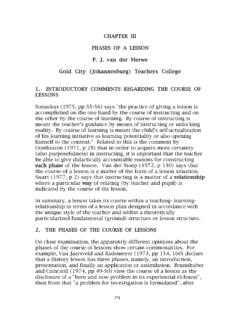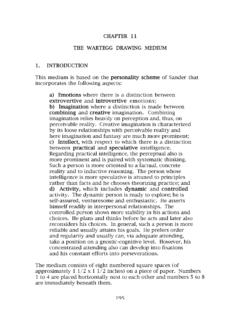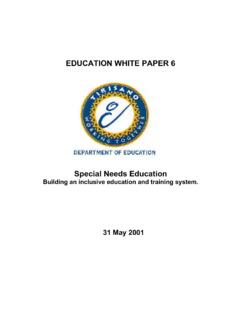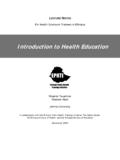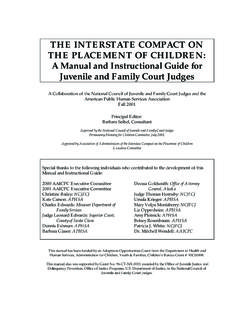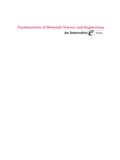Transcription of CHAPTER VII TEACHING AND LEARNING AIDS IN …
1 66 CHAPTER VIITEACHING AND LEARNING aids IN THE LESSON STRUCTUREP. J. van ZylRand Afrikaans University1. INTRODUCTIONWhen there is talk of TEACHING and LEARNING aids in the lessonsituation, by no means is there an attempt to plead for their use inteaching. At this stage of TEACHING , we (ought to) have alreadyadvanced far enough so that it no longer is necessary to make a casefor the use of media. Research has shown that if used appropriatelyand in the right place, they contribute to purposeful TEACHING . A fewrelevant terms are considered Audiovisual aids *Certainly the best-known and most used term is "audiovisual aid".This amounts to the teacher or docent using a number of aids to tryto improve his TEACHING . These aids are directed particularly at theauditory and/or visual senses (separately or together). This isrepresented as follows:Figure 1: The use of audiovisual aidsTeacher/docent Pupil/studentAudiovisual aids (Hinst, 1971, p 43).Various authorities agree that this approach is one-sidedly attunedto apparatuses without considering whether they make a real * Based on Van Zyl, P.
2 J. (1977). Onderwystegnologie in universitereverband. Publication Series of the Rand AfrikaansUniversity, No. to improving TEACHING (Hinst, 1971, p 39; Sekerak andMcDonald, 1969, p 47; Grayson, 1976, p 121). Janssen (1969,p 54) even talks of "gadgeteers" when referring to advocates of thisapproach. Hinst (1971, p 39) summarizes this as follows: "The'gadget' approach of the last 20 years, which was confined topropagating the technical possibilities of media, catering to aminimum of software, in the last analysis, has failed."Various reasons can be offered as to why this approach has notmade much of a contribution to renewing and improving most important certainly are the following:1. The excessive emphasis on apparatus has restrained themeaningful development of programming (Among others seeOettinger, 1969, pp 157-158).2. The great stress on apparatus has lead to a continual swing of thependulum from the use of a particular apparatus ( , 16 mmmoving picture projector) to what has followed ( , television).
3 Each new apparatus developed is then presented as the best aid (Seeamong others Sekerak and McDonald, 1969, p 47).3. The mentioned emphasis on apparatus evoked a negativereaction from very right-thinking teachers and docents because a lotof money was spent on apparatuses that went unused. This negativereaction was stimulated further because proper provision was notmade for planning and producing Little resulted directly from a really meaningful integration ofmedia into Research on the use of aids in TEACHING continually resulted in nodifferences between TEACHING with and without aids (Among others,see Campeau, 1974, p 31; Solomon, 1976, p 25).An analysis of the situation in South Africa indicates that we are stilllargely in the stage of using audio-visual aids . A first breakthroughto something more than audio-visual aids began to be noticed (Seeamong others Conradie, 1977; Meyer, 1974; Strydom, 1976). Theground breaker of this development was certainly the South AfricanArmy's College of Educational TEACHING aids68 Van der Stoep et al.
4 (1973, pp 130-131) use the term " TEACHING aid"to summarize instructional and LEARNING aids . Instructional aids arewhat the teacher uses in presenting a lesson while LEARNING aids areused by the pupils. This is a very fine distinction and it oftenhappens that in one period the same TEACHING aid can be used bothas an instructional and a LEARNING aid ( , a chalkboard). Media*There is a wide diversity of standpoints about what is meant bymedia in TEACHING . De Cecco (1968, p 527) represents the approachconcerning audio-visual aids that is in agreement with the abovepronouncements as follows: "The electro-mechanical devices whichact as middle conditions between the student and what he is tolearn." Here the emphasis is largely on and Ely (1971, p 282) define a medium as any person,material or event that creates circumstances that put the pupils in aposition to acquire knowledge, skills and dispositions. De Corte etal. (1974, p 189) go further and state that a medium is any meansused or presented by a teacher to function in the TEACHING situationin connection with reaching a particular TEACHING aim.
5 Thus, herethere is mention of an integration of the medium into TEACHING andin such a way that it is attuned to attaining particular the literature it is clear that the use of the term "media" hasconsequences for the use of the term "audio-visual aids " (See amongothers Hinst, 1971, p 43). However, some authors such as De Ceccostill use the term "media" as a synonym for "audio-visual aids " whileDe Corte et al., go much further. The views of the latter are entirelyacceptable because they mention programs and apparatuses that donot function only as aids but which are integrated into the term "media" and " TEACHING media" will be used in this chapterwith this TEACHING technology*As noted, the traditional approach to audio-visual aids has not led toa meaningful renewal of TEACHING . However, it is possible that theproblem can be approached scientifically and thus can lead to asystematic integration of media into instruction. Teachingtechnology possibly offers a the late 1960's various overseas authors and commissionshave attempted to describe the use of TEACHING technologies (Amongothers see Bjerstedt, 1969 p 48; Chapman and Unwin, 1969 p 9; Ely,1972, p 36; Ericksson, 1969, pp 62-63; Filep, 1975, p 14; Gilbert,1969, p 57; Hawkins, Hitchens and Wallington, 1974, p 85; Hinst,1971, p 40; Oguri, 1969, p 36; Olson, 1974, p 78; Prigge, 1974, p 18;Silber, 1970, p 24).
6 Since it is not possible to make a completeanalysis of all of the different approaches to TEACHING technologieswithin the space of this CHAPTER only a few influential works will a point of departure, Janssen's (1969, p 56) view of Teachingtechnology will be closely looked at. He defines Teachingtechnology as technical-scientific applications to TEACHING with aview to the aim and structure of TEACHING . This application arisesthrough the mutual attunement of the scientific rules andconclusions about TEACHING (the didactic) and of the technicallawfulness of the apparatus to the desired aim and structure to this definition there is mention of a technologybecause it has two components, namely, a science and a , it is not merely a technology but a teachingtechnology because the technical-scientific applications aredirected to TEACHING and indeed are attuned to its aim and there is only mention of the application of a technique to teachingwhile the scientific ( , didactic) component is missing, this will bein agreement with the view of the so-called "gadgeteers" who are"possessed" by the idea of using different types of apparatuses SummaryIt is possible to talk past each other if we use different terms withvarious meanings.
7 Whatever terms we use, our ideal is the completeintegration of media into TEACHING and thus also into each lesson. Inthe following section a closer look is taken of integrating media INTEGRATING MEDIA AND Introduction70 The truly meaningful integration of media into instructing occurswith a whole complex set of theories that cannot be dealt with addition, a number of practical considerations (see section 5) andalso knowledge of media selection (see section 4) of the most general theoretical points of departure is thatchoice of TEACHING technology amounts to a systems approach toteaching (See among others Chapman and Unwin, 1969, p 9; Filep,1975, p 14; Grayson, 1975, p 131; Hinst, 1971, p 39; Hitchens,1973, p 3). Grayson (1976, p 121) briefly sums this up as follows:"Educational technology, therefore, is currently viewed as a totalsystems approach to education, incorporating hardware, coursematerials, and instructional and management techniques." A fewapproaches to integrating media with instructing Systems approach in TEACHING technology according toBrown, Lewis and Harclroad (1977, p 5)Figure 2A Setting aimsB Circumstances What aims are striven for?
8 How and under what circumstances will the aims try to be reached?1 Aims and content2 LEARNING experiences3 TEACHING approaches PUPILS4 Personnel5 Program and apparatus7 Evaluating and improving6 Physical facilityD RESULTSC MEANS How well is the aim attained? What means are needed for desired LEARNING experiences? Systems approach in TEACHING technology according toCavert (1974, pp 8-9)Figure The elements of a systematic course of teachingaccording to Gerlach and Ely (1971, p 29)72 Figure 4 THE ELEMENTS OF A SYSTEMATIC COURSE OF TEACHNG Determine the strategySpecify the Organization E content of groups v a Evaluate beginning Allot time l Situation & child s u Foreknowledge a Allot space t Specify the e aim Choice of TEACHING SummaryIn all three of the mentioned cases media are only one of thecomponents of a total system.
9 They do not function merely as aidsbut are integrated into the lesson structure. The media that aregoing to be used in a particular lesson will be determined by theaims, the TEACHING strategies, etc. Thus, media only are able to beintegrated into a particular lesson if that lesson is systematicallyplanned according to the three mentioned systems or other , however, the problem is if all of the above is noted, how doesone select the most suitable media for a particular aim?4. SELECTING MEDIAA uthors such as Fourie (1975), Anderson (1976) and Romiszowski(1974) have already contributed greatly to our knowledge of73selecting media. Since the entire problem of media selection is socomprehensive, only a few guidelines from Romiszowski will bediscussed. The aim of this overview is mainly to indicate how mediaselection ought also to be a component of the lesson to Romiszowski (1974, pp 56-58) the following factorsinfluence the selection of media for a particular lesson:1. LEARNING content;2.
10 Type of LEARNING task;3. TEACHING strategies;4. student/pupil characteristics;5. practical limitations;6. preferences of the following two types of media characteristics have to be takeninto account in media selection:1. Essential media characteristics. It is these characteristics that will improve the clarity of the presentation;2. Optional media characteristics. It is these characteristics that will improve the quality of the docent/teach should first reflect on what essential mediacharacteristics should be brought up in a particular lesson andthen give attention to the optimal media characteristics (SeeRomiszowski, 1974, pp 63-64).Then a list of appropriate media should be compiled in terms of theessential media characteristics. Now eliminate the media that areimpractical, unavailable or can't be used in the limited (1974, pp 71-76) gives a whole series of schemes forselecting different media such as visual, verbal, auditory , there has to be a choice of the final combination of media foreach phase of a particular meaningful integration of media into instructing implies anaccountable selection of media and not merely a haphazard SOME PRECONDITIONS FOR INTEGRATING MEDIA ANDINSTRUCTINGThe following are only a few preconditions that arise when reflectingon integrating media and The docent/teacher should have a positive attitude about theuse of media in Media are only one component of the lesson planning that nowhas to be interwoven with the other The docent/teacher has to have knowledge of the possibilitiesand limitations of the various The docent/teacher has to be skilled in using the TEACHING locations/classrooms must be equipped for Apparatuses and programs must be A support service which among other things provides forapparatuses and programs.

